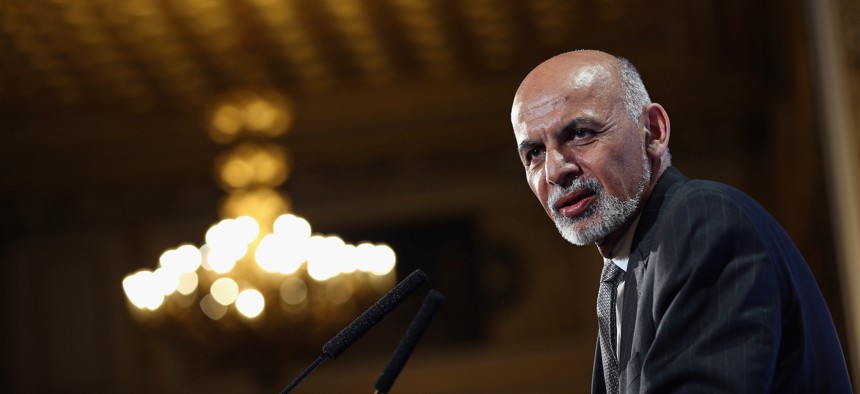
Afghanistan's President Ashraf Ghani speaks to delegates and ministers during the London Conference on Afghanistan on December 4, 2014. Dan Kitwood - WPA Pool/Getty Images
Uncertainty About Post-Withdrawal Plans Clouds Biden’s Upcoming Meeting with Afghanistan’s Ghani
Still, experts say, the White House meeting will be an overdue show of support for the Afghan government.
None of the questions about how the United States will support the Afghan government after September is likely to be answered when President Biden meets President Ashraf Ghani at the White House on Friday. But experts say the meeting is still an important signal that the United States will not abandon Afghanistan as troops complete their withdrawal over the next 80 days.
“That handshake at the White House between President Biden and President Ghani is so important,” said Lisa Curtis, a senior director for south and central Asia on the Trump administration’s National Security Council who is now director of the Indo-Pacific Security Program at the Center for New American Security. “This is really a remarkable show of U.S. support for his government, which I believe is long overdue.”
Biden announced in April that all American forces would leave Afghanistan by Sept. 11, though the military has already completed more than half of the withdrawal and is expected to be fully out much sooner.
The Taliban has failed to live up to its commitments set by the agreement for troops to withdraw, the country’s foreign minister told the United Nations Security Council this week. The group has maintained ties to terrorist groups such as Al Qaeda, and civilian casualties are up 29 percent in the first quarter of the year compared to 2020. Deborah Lyons, the U.N. special envoy for Afghanistan, said at the same event that every problem from security to the economy to COVID-19 is either getting worse or remaining the same.
White House spokesperson Jen Psaki said Ghani’s visit to the White House will “highlight the enduring partnership between the United States and Afghanistan as the military drawdown continues….The United States will remain deeply engaged with the Government of Afghanistan to ensure the country never again becomes a safe haven for terrorist groups who pose a threat to the U.S. homeland.”
What that partnership looks like is still very much up in the air. Experts predict Ghani and Biden will talk about operational details of America’s continued aid to Afghanistan, but none were optimistic that any solutions would be reached or announced this week.
One of the top issues officials still need to figure out is how America can listen for terrorist plots to strike U.S. territory without people on the ground. Defense officials told Congress last month that they do not have a plan to collect intelligence after the withdrawal, and are still working to secure agreements with nearby countries to either allow overflight or host American assets.
Afghanistan shares a border with Tajikistan, Turkmenistan, Uzbekistan, Iran, Pakistan, China and a small stretch that’s disputed between India and Pakistan. “It is a very difficult neighborhood,” David Helvey, the acting assistant defense secretary for Indo-Pacific security affairs, told Congress last month. And Pakistan is no longer even an option, now that Pakistani Prime Minister Imran Khan wrote in the Washington Post this week that the country “cannot afford” the violence it would face if it hosted American bases.
This leaves the United States with no good options to maintain any accurate picture of the threat in Afghanistan, said Javed Ali, a former senior director for counterterrorism at the National Security Council in the Trump administration.
“Without the military to support it, I don’t have a good feeling about our ability to understand what’s happening on the ground in that fine level of detail,” said Ali, a policymaker in residence at the University of Michigan’s Ford School. “We’ve seen this movie in the past, and it’s never good when we significantly reduce that intelligence presence.”
It’s also not clear what form security assistance to Afghanistan will take. It could range from a handful of advisors who would work out of the embassy in Kabul to a small number of advisors who continue to embed with the Afghan army or special operations units, Ali said.
“There’s a sentiment that people are generally positive that the U.S. will remain somehow or somewhat engaged, but the specifics of that have been pretty deficient thus far,” echoed Jason Campbell, a policy researcher at the Rand Corporation and a former Afghanistan country director in the Office of the Secretary of Defense for Policy.
Another open question is how the Afghan military will maintain the equipment that’s currently being serviced by 18,000 contractors who are leaving the country alongside American and NATO troops. Without help on maintenance and repair, the Afghan air force could crumble, depriving the government of a significant advantage over the Taliban, Campbell said.
“If the majority of contractors were to leave...that puts not just the Afghan air force but also the beneficiaries of the air force in a very difficult position,” he said. “You look at the size and landscape in Afghanistan and having the ability to fly forces and logistical requirements around the country is a huge advantage.”
Some experts say they are hoping that Ghani will be able to convince Biden to slow down the withdrawal if he raises all these concerns amid mounting Taliban violence and intelligence that found the Afghan government could collapse just six months after American and NATO troops leave.
But even a more gradual withdrawal won’t solve these problems, said David Sedney, who served as the deputy assistant defense secretary for Afghanistan, Pakistan and Central Asia between 2009 and 2013.
“There’s nothing I can see that would fundamentally change the dynamics that the Taliban are pushing hard for a victory, and the people suffering here are the Afghan people,” he said. “People are worried this could become a humanitarian catastrophe, with hundreds of millions of people fleeing Afghanistan. It could be a Rwanda-like tragedy this administration may be facing as a result of the way it’s carried out policies so far.”




